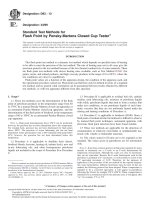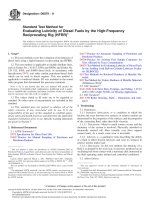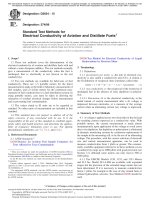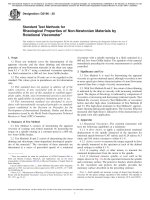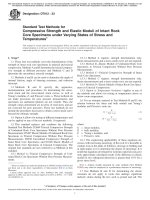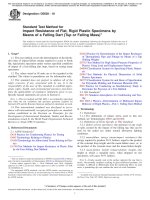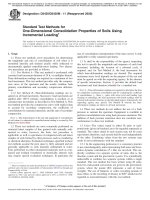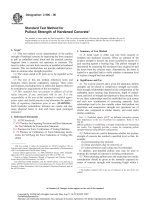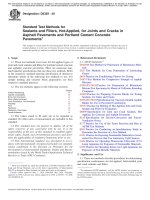ASTM D153-84 (2020) Standard Test Methods for Specific Gravity of Pigment
Bạn đang xem bản rút gọn của tài liệu. Xem và tải ngay bản đầy đủ của tài liệu tại đây (167.42 KB, 5 trang )
This international standard was developed in accordance with internationally recognized principles on standardization established in the Decision on Principles for the
Development of International Standards, Guides and Recommendations issued by the World Trade Organization Technical Barriers to Trade (TBT) Committee.
Designation: D153 − 84 (Reapproved 2020)
Standard Test Methods for
Specific Gravity of Pigments1
This standard is issued under the fixed designation D153; the number immediately following the designation indicates the year of
original adoption or, in the case of revision, the year of last revision. A number in parentheses indicates the year of last reapproval. A
superscript epsilon (´) indicates an editorial change since the last revision or reapproval.
This standard has been approved for use by agencies of the U.S. Department of Defense.
1. Scope 3. Purity of Reagents
1.1 These test methods cover three procedures for determin- 3.1 Purity of Water—Reference to water shall be understood
ing the specific gravity of pigments, as follows: to mean reagent water as defined by Type II of Specification
D1193.
Test Method A—For Routine Testing of Several Samples
Simultaneously. TEST METHOD A—FOR ROUTINE TESTING OF
SEVERAL SAMPLES SIMULTANEOUSLY
Test Method B—For Tests Requiring Greater Accuracy than
Test Method A. 4. Apparatus and Materials
Test Method C—For Rapid and Accurate Testing of Single 4.1 Pycnometer—A pycnometer (Note 1) having a 50-mL
Samples. capacity.
1.2 The specific gravity value obtained by these procedures NOTE 1—The Weld type with the cap seal on the outside of the neck of
may be used with the weight of a dry pigment to determine the the bottle is preferred because there is less danger of trapping air just
volume occupied by the pigment in a coating formulation. under the capillary tube than with types having the ground glass seal on
the inside of the neck.
1.3 The values stated in SI units are to be regarded as the
standard. The values given in parentheses are for information 4.2 Water Bath, maintained at 25 6 0.5°C and equipped
only. with a stirring device.
1.4 This standard does not purport to address all of the 4.3 Manometer, open- or closed-tube (see Part f of the
safety concerns, if any, associated with its use. It is the apparatus for Test Method C), made of glass tubing 6 mm in
responsibility of the user of this standard to establish appro- diameter, fitted with rubber pressure tubing attached to a
priate safety, health, and environmental practices and deter- T-joint leading to the desiccator and the pump. For the
mine the applicability of regulatory limitations prior to use. open-tube type 860 mm of mercury shall be used. The
For specific hazard statements, see Sections 5, 11, and 15. difference in levels of the mercury in the manometer when the
system is in operation, subtracted from the barometer reading
1.5 This international standard was developed in accor- taken at the same time, shall be considered the absolute
dance with internationally recognized principles on standard- pressure of the system in millimetres of mercury.
ization established in the Decision on Principles for the
Development of International Standards, Guides and Recom- 4.4 Desiccator, glass, constructed with heavy walls to with-
mendations issued by the World Trade Organization Technical stand a vacuum of one atmosphere, and with an opening at the
Barriers to Trade (TBT) Committee. side.
2. Referenced Documents 4.5 Vacuum Pumps—A laboratory water vacuum-type pump
2.1 ASTM Standards:2 (Note 2), to remove the greater portion of air in the desiccator,
D1193 Specification for Reagent Water and an oil vacuum-type pump, motor-driven, and capable of
reducing the absolute pressure of the system to 3 mm.
1 These test methods are under the jurisdiction of ASTM Committee D01 on
Paint and Related Coatings, Materials, and Applications and are the direct NOTE 2—The water vacuum pump may be omitted if the rate of
responsibility of Subcommittee D01.31 on Pigment Specifications. evacuation with the oil pump can be controlled so as to avoid a rapid
ebullition of entrapped air and possible loss of specimen.
Current edition approved June 1, 2020. Published June 2020. Originally
approved in 1923. Last previous edition approved in 2014 as D153 – 84 (2014). 4.6 Thermometer, having a range from 0 to 60°C, and
DOI: 10.1520/D0153-84R20. graduated in 0.1°C divisions.
2 For referenced ASTM standards, visit the ASTM website, www.astm.org, or 4.7 Weighing Bottle, wide-mouth cylindrical glass (about 30
contact ASTM Customer Service at For Annual Book of ASTM mm in height and 70 mm in diameter), provided with a
Standards volume information, refer to the standard’s Document Summary page on ground-glass stopper.
the ASTM website.
Copyright © ASTM International, 100 Barr Harbor Drive, PO Box C700, West Conshohocken, PA 19428-2959. United States
D153 − 84 (2020)
4.8 Immersion Liquid—Kerosine has been found to be a proper vacuum. When the manometer indicates that the abso-
good wetting vehicle for most pigments, and shall be used lute pressure is 3 mm and constant, cut off the oil pump for
generally as the immersion liquid. Refined, white kerosine of short periods, taking care that the vacuum does not change
narrow evaporation and boiling range shall be used. With some materially due to leakage. At first bubbles of air rise from the
pigments that are not wetted well with kerosine, other immer- pigments very rapidly, then this action gradually decreases and
sion liquids such as glycerin, ethylene glycol, finally stops. The time required for complete removal of air
tetrahydronaphthalene, etc., may be substituted. The liquid may vary from 30 min to 24 h, depending upon the nature of
must have a low evaporation rate and narrow boiling range, the pigment. When no more bubbles can be seen, it may be
and the same procedure shall be followed as with kerosine. assumed that the occluded air has been removed and that the
Water is not a preferred liquid because of the possibility of pigment is thoroughly wet with kerosine. Then slowly admit
frothing. air to the desiccator by means of the pinchcock.
5. Hazards 7.6 Filling and Bringing to Temperature—Remove the py-
cnometer from the desiccator, fill with kerosine at 24 to 25°C
5.1 Before a desiccator is used for the first time, wrap it in taking care to add a sufficient quantity to prevent air bubbles
a towel and test under an absolute pressure of under 3 mm. where the pycnometer is closed, and permit to come to constant
Exercise care in handling the desiccator when under vacuum, temperature at 25 6 0.5°C in the water bath. Carefully stopper
since a sudden jar may cause it to collapse. the pycnometer and remove excess kerosine with lens paper.
Take the pycnometer out of the bath, allow to come to room
6. Standardization of Pycnometer temperature, and weigh.
6.1 Fill the pycnometer with freshly boiled water at 23 to 8. Calculation
24°C, gradually bring to 25 6 0.5°C, and then dry and weigh 8.1 Calculate the specific gravity, S, of the pigment as
as specified in 7.6. Empty the pycnometer, and clean, dry, and
reweigh it. Next fill the pycnometer with kerosine at 23 to follows:
24°C, bring to 25 6 0.5°C, dry, and weigh as before. Calculate
the specific gravity, S, of the kerosine at 25/25°C as follows: S 5 P1 (2)
W 2 K1
S 5 A/B (1) D
where: where:
P1 = weight of pigment used, g,
A = weight of kerosine, g, and W = weight of water to fill the pycnometer, g,
B = weight of water, g. K1 = weight of kerosine added to the pigment, g, and
D = specific gravity of the kerosine.
7. Procedure
9. Precision
7.1 Drying—Dry the pigment, preferably in an electric 9.1 Duplicate determinations by this test method should not
oven, at 105 6 2°C for 2 h.
differ by more than 0.02.
7.2 Weighing—Transfer to a clean, dry, weighed TEST METHOD B—FOR TESTS REQUIRING
pycnometer, sufficient sample to form a layer approximately 20
mm (3⁄4 in.) deep. For black, blue, and lake pigments of low GREATER ACCURACY THAN TEST METHOD A
specific gravity, use about 1 g of sample; for inert crystalline
pigments, about 4 g; for opaque white pigments, 7 to 10 g; and 10. Apparatus (see Fig. 1 and Fig. 2)
for red lead, from 15 to 20 g. Weigh pigments of a hydroscopic 10.1 Pycnometer, Water Bath, Manometer, Vacuum Pump,
nature from the weighing bottle.
Thermometer, Weighing Bottle, and Immersion Liquid—See
7.3 Number of Specimens—Run all samples at least in Section 4; also Fig. 2 (e) and (f ).
duplicate.
FIG. 1 Apparatus for Test Method B
7.4 Addition of Kerosine—Add enough kerosine to the
pycnometer to form a clear layer approximately 1⁄4 in. (6 mm)
above the pigment. When necessary, stir the specimen with a
polished round-bottom glass rod until completely covered by
kerosine, adding more kerosine if necessary. Wash the rod with
kerosine, adding the washings to the pycnometer.
7.5 Removal of Occluded Air—Place the pycnometer in the
desiccator. Close the desiccator and attach to the water pump
until the greater part of the air is removed from the system.
Complete this procedure within a period of 5 to 10 min. Close
the system with a pinchcock and attach the desiccator to the oil
pump for the removal of the small amounts of air given off at
the low pressures obtainable with the oil pump. Use the
manometer to indicate whether the oil pump is giving the
2
D153 − 84 (2020)
FIG. 2 Apparatus for Test Method C
10.2 Bell Jar, glass, with a two-hole rubber stopper. Into one TEST METHOD C—FOR RAPID AND ACCURATE
hole of the stopper shall be fitted a separatory funnel with a TESTING OF A SINGLE SPECIMEN
well-ground stopcock (Fig. 1 (c)), extending into the pycnom-
eter. Into the other hole of the stopper shall be fitted a glass 14. Apparatus (see Fig. 2 and Fig. 3)
tube with a well-ground three-way stopcock (Fig. 2 (d)) and
connected with the vacuum pump (Fig. 2 (e)). The bell jar shall 14.1 Buret, 100-mL, with a 75-mL bulb in the upper part,
rest on a sheet of rubber, cemented or vulcanized to a glass or and with the lower part (25 mL) graduated in 0.05-mL
iron plate. With stopcock c closed and stopcock d open to the divisions (see Fig. 3).
pump, the system shall maintain an absolute pressure of at
most 3 mm. A desiccator may be used instead of a bell jar. 14.2 Flask—A special 100-mL graduated flask (Fig. 2 (b))
with ground-glass stopper. The flask shall be thick enough to
10.3 Bottle, storage, (Fig. 2 (h)) for kerosine or other withstand an absolute pressure of 1 mm, and shall weigh
wetting liquid. between 50 and 60 g. The neck of the flask shall be graduated
in 0.05-mL divisions between the 99 and 100-mL marks. The
11. Hazards dimensions of the flask shall be as shown in Fig. 2.
11.1 Before a bell jar (or desiccator) is used for the first 14.3 Stopcocks—A tightly ground stopcock (Fig. 2 (c)) as
time, test under a vacuum as described in Section 5. part of buret, a, and a three-way stopcock (Fig. 2 (d))
connecting with the vacuum pump, e. To prevent leakage of
11.2 Use a buret stopcock (Fig. 2 (c)) that is well ground kerosine use a buret stopcock (Fig. 2 (c)) that is well ground
and lubricated with silicone lubricants or use a PTFE-coated and lubricated with silicone lubricant or use a PTFE-coated
stopcock. stopcock.
12. Procedure 14.4 Vacuum Pump—See 4.5; also Fig. 2 (e). In this
procedure the oil vacuum pump shall be capable of reducing
12.1 Place the pycnometer containing the weighed, dried the absolute pressure of the system to 1 mm.
pigment under the bell jar. Close stopcocks c and d, start the
vacuum pump, and then gradually open stopcock d to the 14.5 Manometer, Thermometer, Weighing Bottle, and Im-
pump. When an absolute pressure of 3 mm has been attained mersion Liquid—See Section 4; also Fig. 2 (f).
and can be maintained, fill the separatory funnel with kerosine,
close stopcock d, and gradually open stopcock c, adding 14.6 Bottle—See 10.3.
sufficient kerosine to cover the pigment. Then stop the pump
and release the suction at stopcock d. Finally, fill the pycnom- 15. Hazards
eter with kerosine, and complete the test as described in 7.6 and
Section 8, under Test Method A. 15.1 The variations that occur under normal conditions in a
room do not materially affect the specific gravity of a pigment.
13. Precision However, take care that the temperature of the liquid after
transferring to the flask is approximately the same as it was
13.1 Duplicate determinations by this test method should when in the buret.
not differ by more than 0.01.
3
D153 − 84 (2020)
16. Standardization of Apparatus
16.1 Connect the flask to the buret and the pump by means
of a two-holed rubber stopper. Evacuate the system with the
buret stopcock (Fig. 2 (c)) closed until the pump maintains an
absolute pressure of 1 mm in the flask. Close the three-way
stopcock, d, for 30 s, and again open to the pump. There shall
be no appreciable change in the mercury levels in the
manometer, indicating that the system beyond stopcock d is
tight. With the vacuum still maintained, fill the buret from the
top with kerosine, adjusting the level to the zero mark with a
piece of capillary tubing. Now close stopcock d, and carefully
open stopcock c, admitting about 75 mL of kerosine into the
flask. Open stopcock d to the air, thus releasing the vacuum in
the flask, and fill the flask with kerosine to a definite mark on
the neck. Read the buret, calling this reading K2 (the volume of
the flask).3
Buret: Geissler, straight; glass stopcock, ground accurately. 17. Procedure
Total capacity 100 mL 17.1 Clean the flask dry, and weigh. Transfer a quantity of
the dry pigment to be tested to the flask by means of a clean,
Capacity of bulb 0 to 75 mL dry, glass funnel with the stem reaching to the bottom of the
bulb. A piece of stiff nickel wire is convenient to push the
Graduated 75 to 100 mL powder down the stem. Nearly fill the bulb of the flask with the
pigment, which, however, shall occupy a volume of less than
Subdivisions 0.05 mL 25 mL after all air is expelled. Greater accuracy may be
obtained with a large specimen than with a small one. Wipe the
Rate of outflow about 2 min inside stem as well as the entire outside of the flask with a clean
piece of dry, lintless cloth. Weigh the flask and pigment, and
Permissible variations: calculate the weight of pigment by deducting the weight of the
empty flask. With the buret clean and dry, attach the flask to the
Capacity, total ±0.10 mL evacuating system as shown in Fig. 2. After closing stopcocks
c and d, start the pump and carefully open stopcock d to the
Capacity graduated portion ±0.03 mL pump. Continue evacuation until the pump maintains an
absolute pressure of 1 mm in the flask, or until all the air is
Markings on graduations shall be in conformity with the National Bureau of removed from the system. Then fill the buret from the top as
described in Section 16, close stopcock d, gradually open
Standards Circular No. 9.3 stopcock c, and add kerosine until the pigment is covered. Tap
the flask gently to dislodge any air bubbles. Stop the pump,
FIG. 3 Buret in Apparatus open stopcock d to the air, and fill the flask up to the same mark
as was obtained in determining its volume. Designate the
15.2 Since in determining both K2 and V the tip of the buret volume of kerosine required as V. Read the height of the liquid
and bore of the stopcock plug are empty, no correction is to be in the buret to the nearest estimated 0.01 mL.
made; but stopcock c must be so well ground that under an
absolute pressure of 1 mm for 30 min no leakage of kerosine 18. Calculation
shall take place. The usual sources of error are failure to
remove all the air from the pigment, and leaks in the system. 18.1 Calculate the specific gravity, SG, of the pigment as
Use a minimum amount of rubber tubing in the system and, follows:
wherever it is used, coat the joints between rubber and glass
with a melted mixture of beeswax and rosin. SG 5 P2/~K2 2 V!
15.3 In cleaning the flask of kerosine only, a rinsing two or where:
three times with ether, followed by dry air (dried over sulfuric P2 = weight of pigment used, g,
acid and calcium chloride), is considered sufficient. When K2 = volume of kerosine required to fill the flask when
pigment is also present, remove both pigment and kerosine and
follow with ether rinses until no more pigment remains. Add empty, mL, and
some filter pulp (macerated filter paper) and water (with or V = volume of kerosine required to fill the flask when the
without glass beads), and shake vigorously. Repeat if neces-
sary. Rinse the flask with reagent water, and either dry in an pigment is present, mL.
oven, or rinse with alcohol and ether followed by dry air.
3 Available from National Institute of Standards and Technology (NIST), 100
Bureau Dr., Stop 1070, Gaithersburg, MD 20899-1070, .
4
D153 − 84 (2020)
19. Precision 20. Keywords
20.1 pigments; specific gravity
19.1 Duplicate determinations by this test method should
not differ by more than 0.01.
ASTM International takes no position respecting the validity of any patent rights asserted in connection with any item mentioned
in this standard. Users of this standard are expressly advised that determination of the validity of any such patent rights, and the risk
of infringement of such rights, are entirely their own responsibility.
This standard is subject to revision at any time by the responsible technical committee and must be reviewed every five years and
if not revised, either reapproved or withdrawn. Your comments are invited either for revision of this standard or for additional standards
and should be addressed to ASTM International Headquarters. Your comments will receive careful consideration at a meeting of the
responsible technical committee, which you may attend. If you feel that your comments have not received a fair hearing you should
make your views known to the ASTM Committee on Standards, at the address shown below.
This standard is copyrighted by ASTM International, 100 Barr Harbor Drive, PO Box C700, West Conshohocken, PA 19428-2959,
United States. Individual reprints (single or multiple copies) of this standard may be obtained by contacting ASTM at the above
address or at 610-832-9585 (phone), 610-832-9555 (fax), or (e-mail); or through the ASTM website
(www.astm.org). Permission rights to photocopy the standard may also be secured from the Copyright Clearance Center, 222
Rosewood Drive, Danvers, MA 01923, Tel: (978) 646-2600; />
5
